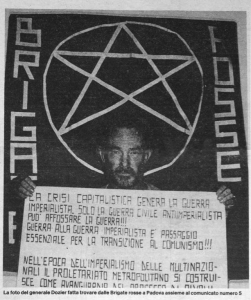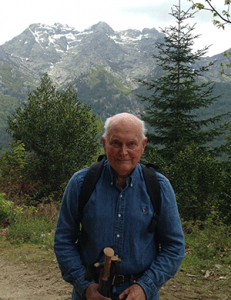by Peter Bridges
In 1981 I was assigned to our Rome embassy as the deputy to the ambassador, Maxwell Rabb. The Red Brigade terrorists had been active in Italy for some years. They had been responsible for perhaps thousands of violent actions and had killed many people, most notably former Prime Minister Aldo Moro in 1978.
One day before I left Washington, my colleague Gary Matthews said “You are going to carry a weapon in Rome, I assume.”
“Why, no. I don’t have one and I don’t plan to buy one.”
“Go down to the Department armory and they’ll fix you up.”
I had no idea the State Department had an armory. I went there and asked if they could issue me a small derringer that would fit in a jacket pocket. They offered me a bulky .38 caliber pistol and holster which, when I tried them on, made a bulge in my suit jacket. I imagined walking across the lobby of the foreign ministry in Rome, and the pistol falling and clattering across the marble floor…or walking through the Villa Borghese park and shooting an obvious terrorist who came at me, and who turned out to be an innocent father of four. No, thank you.
After I got to Rome, in October 1981, there was a time or two when I wondered if I’d made the wrong decision. The so-called Red Brigades, born out of the student rebellion of the late 1960s, were continuing their nefarious activities, although they had utterly failed to gain the popular support they had hoped for.
So far there had been no attacks on Americans in Italy, but my counterpart in Paris, Christian Chapman, walked out of his house one morning and was fired on by a young terrorist. Fortunately, he was a poor shot and missed him.
On a Thursday evening in December my wife and I were sitting in bed reading, glad to be free for once from a diplomatic dinner. The bedside phone rang. It was the diplomatic adviser to Prime Minister Giovanni Spadolini.
“Peter,” he said, “An American general has been kidnapped in Verona. We’ve set up a command center here in Palazzo Chigi and I suggest you send an officer to join us.”
I called our political counselor, Robert Frowick, and he sped off to the command center.
Ambassador Rabb was in Genoa, having driven there to give a speech. He had an armored Cadillac and traveled with an escort of two police cars—but Aldo Moro had been kidnapped while traveling with a police escort, five members of whom were killed. I reached the ambassador by phone in Genoa, and told him I thought he should stay where he was; who knew but that the Red Brigades might set up a roadblock to capture him.
No, said Max Rabb, I’m coming back. He drove down to Rome through the night, got perhaps an hour of sleep after reaching his residence, and went off to tell the Prime Minister that we counted on the Italians to rescue our man and we would provide all possible help.
The kidnap victim was Brigadier General James Dozier, whom I had met recently at our embassy. He was a trim West Pointer, aged fifty, who was serving as chief of staff at a small NATO headquarters in Verona. Late on a Thursday he and his wife were home when someone knocked on their door: four men with a large tool box. They were plumbers, they explained, sent to investigate a leak in the apartment below that might originate at the Doziers’.
Alas, the Doziers let them come in. They were not plumbers. They tied up Mrs. Dozier, squeezed the general into the box, and took him away.
Soon we began to receive Red Brigades communiques. They talked about fighting capitalism and imperialism but did not make demands to be met for the general’s release. That was worrisome. They had held Aldo Moro for six weeks, and after a lot of messages had killed him.

We wondered if they had more American targets in mind. There were many thousands of Americans in Italy. Most were private citizens but the official U.S. presence included military bases, our embassy, and seven consulates. It was a worrisome time. We told staffs to be cautious, vary their travel routes, and report anything suspicious. They were of course worried, but they didn’t show it. Just one officer asked to be sent home, saying he feared for his wife and children.
A young deputy assistant secretary of defense phoned me. The Pentagon would send us ten or twelve analysts. Obviously the Italians were incapable of finding Dozier on their own. After all, they had two different police forces, the Carabinieri and the Poliizia di Stato. Well, I said, there were at least half a dozen police forces in the District of Columbia. We did not need any analysts; we needed the best intelligence Washington could send us.
There is a claim that the Italians acted on intelligence supplied by the Pentagon. Not so—but the Pentagon did send us, and I gave to the Italians, a report from “a reliable source” that our general was being held in a medium-sized city with red roofs and a large cathedral, located on a hillside. Who was this source, the Italians asked. The Pentagon would not tell me, but sent us a second report with more detailed information. The Italians insisted on knowing where the information came from. The deputy assistant secretary of defense finally told me, but said I must not tell the Italians….the source was a psychic! I told the Italians that the reports were worthless.
Then the Pentagon offered us a small unit from the Delta Force. That was more like it, and in a day they showed up at the embassy: a half-dozen men led by a lieutenant colonel. They were trim and impressive, but none of them spoke Italian and none had served in Italy. We offered them to the Carabinieri. After some days I was told that a report had been received that Dozier was perhaps being held in a village in the Apennines north of Bologna. Would our unit like to join a Carabinieri operation there? Yes, indeed, and on a weekend they headed off. And on Monday the Italians, who had learned from an informer where Dozier was being held, freed him, not in the mountains but from an apartment just above a busy supermarket in Padua. I have always wondered if the Italians decided to get the Delta Force politely out of the way while they broke into the Padua apartment.
I was in my office that morning. The ambassador had gone to see the Minister of Interior. My secretary, Maria Lo Conte, came in. The police station in Padua was on the line and they wanted to talk to me. I picked up the receiver and a strong voice said “Hi! This is Jim Dozier.” I almost broke down.
The kidnappers had pitched a camping tent in the apartment, and for six weeks Dozier was chained by his right wrist and left ankle to a cot in the tent, and made to wear earphones with music blaring. He exercised as best he could, and reportedly suffered only some damage to his hearing. He told a journalist that he usually thought things worked out for the best, “but certainly there were high and low points.” An admirable man. He was assigned to Fort Knox, and later promoted to major general.
Terrorism continued in Italy. There were fewer incidents—but in early 1984 two terrorists murdered my friend Leamon Ray Hunt, who had retired from our Foreign Service to become the director general of the Sinai peacekeeping force, headquartered in Rome. I was all the more saddened by his death because I had suggested to Ray that he look for a job with an international organization after retiring from our Service. These are things one doesn’t forget.![]()

Peter Bridges spent three decades as a Foreign Service officer on four continents, ending as ambassador to Somalia. In recent years he has published a memoir of his time as a diplomat; biographies of two once-famous Americans, John Moncure Daniel and Donn Piatt; and a memoir of his off-hours climbs, runs, and treks. His articles, essays, and poems have appeared in American Diplomacy, Copperfield Review, Diplomacy & Statecraft, Eclectica, Mountain Gazette, Virginia Quarterly Review, and elsewhere.
